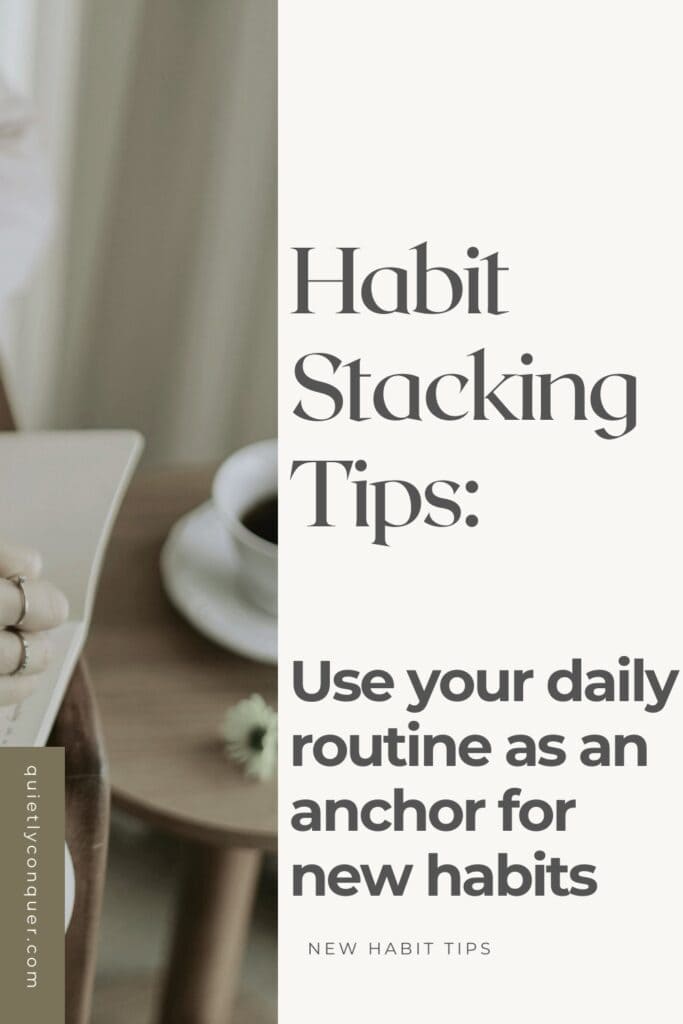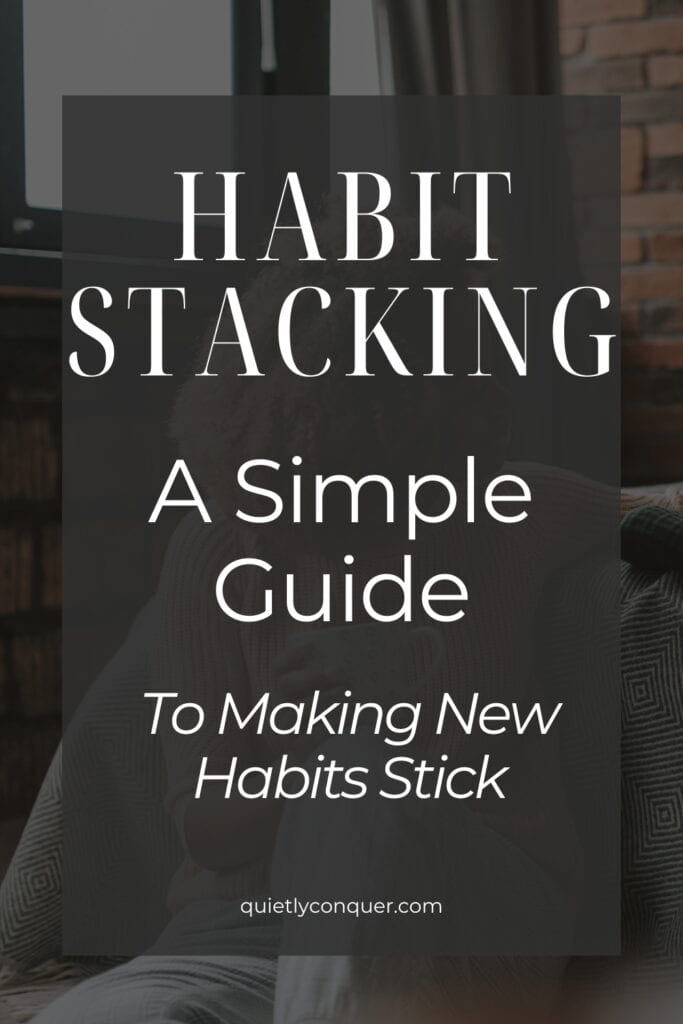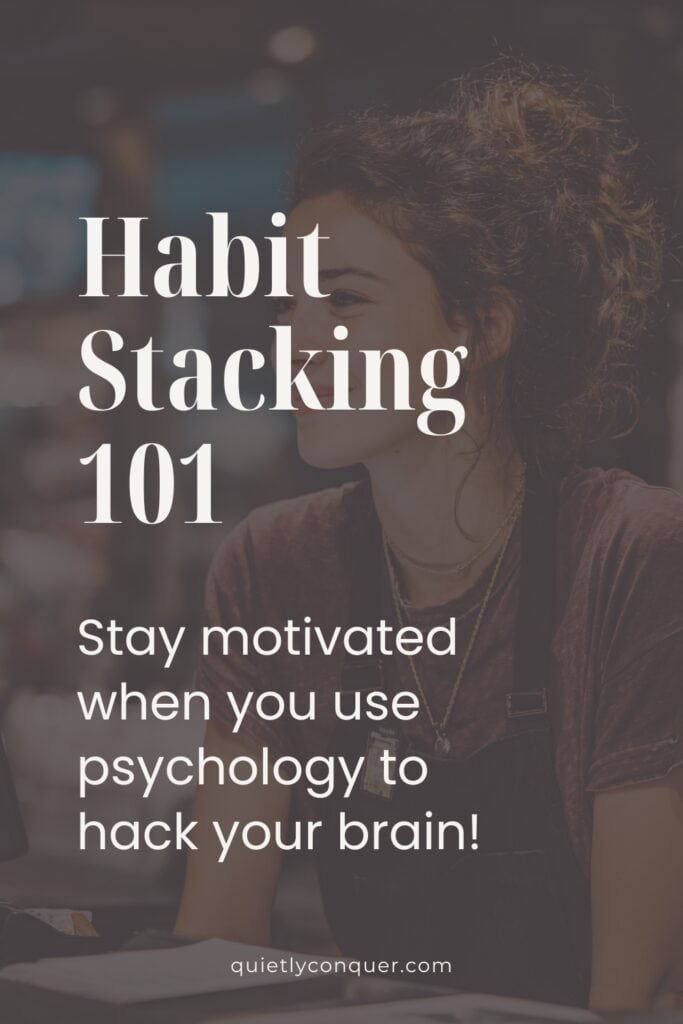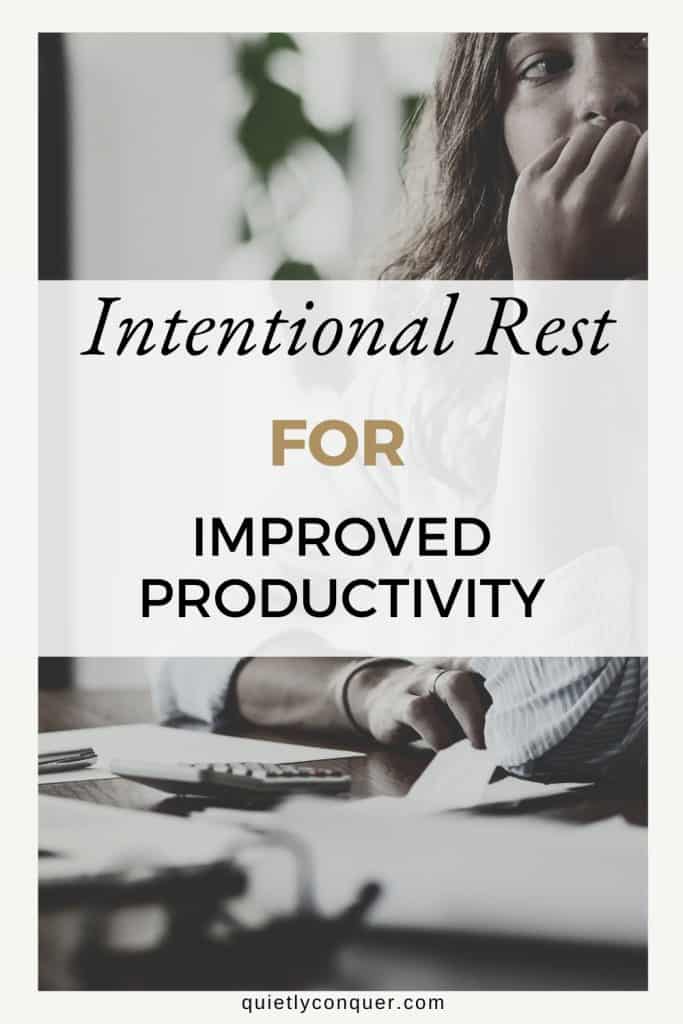Discover Habit Stacking For Better Productivity

Habit Stacking
Do you often feel overwhelmed with 100's of ideas, projects and to-do lists, unsure how to give them all the attention they need?
Does the constant juggling of your business or work, alongside family life, low energy and countless other commitments feel impossible at times?
If you can relate, then habit stacking may be the key for you to create a quiet, but confident rhythm that brings balance and calm back into your life.
Habit stacking helps you to introduce and maintain supportive routines without adding more pressure. When you link new habits with ones that are already established, it feels less intimidating. It can help new habits become established quicker, saving you time, energy and stress.
*Affiliate Disclosure: Some links in this post may contain affiliate links. If you purchase something via the link, I may receive a small commission. This doesn't affect the price you pay.
If you have any questions, reach out for a chat [email protected] or check out my other blogs
Table of Contents
What is Habit Stacking?
The Science Bit:
What is a habit? A habit is a learned behaviour that becomes automatic through reinforcement and repetition (for example, repeating the action daily).
When you repeat an action, you create and strengthen the neural pathways in your brain associated with that habit or action. As well as strengthening the ones used frequently, your brain will prune away (forget) the neural connections used infrequently.
The problem people face is that your brain doesn't like new. It can perceive new as danger, and will want you to stick to what you know and what it is comfortable with, even if it's unhealthy or unhelpful. It's because your brain's main focus is survival and preserving your energy so you stay safe.
Sticking to things that you know (you've survived doing it this way so far!) is an instinctive safety behaviour, and why it feels awkward or uncomfortable at first.
Habit stacking is simply the act of attaching a new habit to an existing one. It offers a structured approach to forming simple and repeatable new habits by giving them an anchor with the existing routines.
The current habits act as the cue in behaviour change. Once you do the action, you’re then cued to also do the new one. It’s much easier to build a new habit onto an existing one because of neuroplasticity (the ability to rewire your brain throughout your life).
This is why attaching any new behaviour or habit to an already strong one (like cleaning your teeth), you will experience much less resistance when introducing the new habits.
By aligning our goals with automated behaviors, we can minimize the mental burden and resistance often faced in behavior change efforts.
Wendy Wood
Benefits of Habit Stacking
There are many benefits of adopting habit stacking, including:
Long-term Change: If you find it hard to stick to things (think of those unrealistic New Years Eve promises made proudly to yourself each year), habit stacking make these changes much more realistic, without needing to overhaul your entire routine.
Less Resistance and Effort: By linking the new habit to existing ones, it’s less likely to trigger the resistance you can feel in those early days. You're also using less energy because you've removed the decision-making aspect, and instead take the cue from an already established behaviour. It's like a shortcut hack to strengthening the new neural pathway and making it automatic.
Improved Productivity: Habit stacking can help you streamline your current working practices. For example, chunking similar activities together, helping you to stay focused and in the zone.
Momentum and Confidence: Habit stacking means you prove to yourself on a daily basis that you can achieve what you set your mind to. It makes starting new habits, and maintaining consistency easier. When you remove emotion from decision making, instead allowing the cues to trigger your desired behaviour, you save energy, and lessen the resistance day by day.
Identify Your Key Habits
To start, you need to take a microscope and analyse your day. So many of the actions you do day after day are done on autopilot – you don't even notice you do them. Depending how much time you have, either keep a track of your actions for a day and night, then come back to this. Or, just spend some time thinking about everything you do from the second you wake until you go to bed.
Think about how you organise yourself, your morning routine, the things you do every day. Then, spend some time journaling or brain-dumping these reflections:
Current, established habits – Jot down all of your habits. think big and small here. A habit can be as small as stretching in bed when you wake up, or cleaning your teeth.
Current daily routine or schedule – Is it busy / chaotic / does it have room for more?
Your personal preferences – What do you enjoy What energises you?
Current goals – What goals do you have? These can be personal or professional.
Future Vision – What you want your day-to-day life to look like. For example, Less time on the computer, more movement, or more quiet time.
Time – What time do you actually have available. It's pointless planning new habits when you don't have the time to do them.
New habits – Think about the habits you want to introduce. Be free with this, you can refine later once you consider all of the other points.
New Habit Stacking Ideas:
- Morning Routines: Choose habits like meditation, listening to relevant podcasts, or adding journaling as part of your new and improved routine. These will enhance your mindset as well as setting you up well for the day ahead. How can you link these to your current established habits?
- Physical Activity: Identify habits where you can link activities with a daily task. I do this every morning. I walk on my under desk walking pad for up to an hour and use that time to research or write a blog, admin tasks, watch some training, or listen to a podcast. As well as boosting my productivity by checking things off of my to-to list, it also helps to keep my movement up when I work from home at my desk most days.
- Mindful Rest Breaks: Stack self-care and rest habits to help break up the day and give your brain a much needed break. You could do a short meditation or take a quick walk. Allowing yourself to totally switch off from data and information is a brilliant way to refresh your mind and enhance concentration and productivity.
If you’re worried that you won’t stick to the new habits, start small, and start with only one. Link to current solid habits that will act as a cue for you.
Other Examples:
- Journaling as you enjoy your morning coffee.
- When you get ready for bed, put your gym gear out ready for the following morning.
- Whenever you finish a task you get up and move around for a step-count habit.
When you have good routines in place, it not only helps you feel more confident and in control, it will improve your productivity because your mind will feel less cluttered.
Momentum is so much easier to maintain once the changes have been made and you’ve made it as easy as possible for you.
Maintain Consistency
Maintaining consistency is key with habit stacking. You can help make this easier for yourself by setting clear and achievable goals for each new habit that you want to introduce.
Tracking your progress is also key, because it will help you stay accountable, allowing you to see realtime progress, which can be really motivating.
Building new habits will take you time and effort to begin with, but with habit stacking, it can feel much easier. Be open to making changes and adapting your goals along the way as you discover things that you want to do more or less of.
Celebrate small wins every day! When you celebrate your achievements and reflect on your lessons, you will build confidence which is motivating. If you only focus on what you haven’t yet achieved, or how far away the end goal is, it can feel overwhelming.
Giving yourself a high five and acknowledging your progress feels so good! When you’re feeling a little flat, take the time to reflect on how far you've already come.
“Success is the product of daily habits – not once-in-a-lifetime transformation”.
James Clear
Other Examples of Habit Stacking
S.J. Scott, author of Habit Stacking: 97 Small Life Changes That Take 5 Minutes of Less describes habit stacking as :
“Linking habits together is a way of getting more done in less time, resulting in a positive change in your life. As you perform the stacked actions every day, they become part of your daily routine.”
S.J. Scott
Scott shares his ideas for creating a daily “habit stack” which consists of developing a daily routine where you complete several mini habits of around 5 minutes each, up to around 30 minutes.
Scott suggests that each small habit needs to be a “complete action”. He also says it’s best to not include things like exercise if you could spend more time on that.
James Clear also writes about habit stacking in this great article How to Build New Habits by Taking Advantage of Old Ones
James discusses the science behind building new habits. He discusses how connecting the new habit to a current habit / daily behaviour is one of the best ways to do so.
He includes a “formula” for habit stacking:
After/Before (Current Habit), I will (New Habit).
Tools, Resources & Support
Take a look at these tools & resources that will help you with your intentional planning, seasonal goals and personal growth:
90-Day Planner – This printable 90-Day planner is the perfect companion for you as you set your focus for the next 3 months. Use it every 90 days to help build consistent habits and achieve your goals with ease. With a focus on intentional planning and moving forward at your own space, it's the perfect companion to see you through to the end of the year.
Soft Systems Society – If you want to learn how to use Notion and grab some AMAZING dashboards, I highly recommend joining Jakolien. As someone who was scared of Notion and found it too complicated, I now use it daily thanks to the best daily planner system I've ever used. I cannot recommend it enough. My ND brain feels settled, goals are clear, tasks are right there for me to see, so no more decision fatigue, and a much calmer mind. Jakolien has recently rebranded to support with all areas of managing time and effort as well as her Notion work, which is great if you find it hard to keep momentum going.
Life Balance Wheel – Gain clarity of your current reality, identify areas that may be holding you back, and create a plan to make long lasting change.
Impact Stationery – Have you ever dreamed of creating your own high-end stationery products? Laura has an amazing course & community designed to help you created printed products that you can market on Amazon, or your own website. It's different to KDP in that they're not print on demand, and the quality of products are incredible.
Elite Sourcing Collective – Laura has also introduced a brilliant new tier in her Elite Sourcing Collective. With free access to Impact Stationery as part of this offer, you also get to take part in a 6-week sprint, and have access to one of her recommended manufacturers, making the step into bringing your product to life even easier. Highly recommend being part of this group. At $999 per year, and with access to ISC – it's an incredible deal!
Grow With Evelyn – Evelyn is an extraordinary coach. GWE is the best membership I've been in. The level of support, the courses, challenges & community are exceptional. Highly recommend if you're a coach, digital creator or small business owner. Evelyn has just introduced a lower price point as well for only $33 per month / $777 per year
Final Thoughts
Habit formation takes time and it’s natural to feel resistance at first. Our brains don’t like change – it likes to take comfort in what it knows. When you introduce new habits or routines, you can find yourself in battle with your mind. By linking the new habits to ones already ingrained in your life, it makes it a little easier.
When you habit stack you can also further streamline your current working practices, your work life balance and your productivity.
Remember to be specific with both the trigger (cue) for the new habit, as well as the goals and expectations. For example, “I will journal for 5 minutes as I drink my coffee” Or, “On my morning walks outside I will listen to a podcast”.
As a multi-passionate therapist and business owner with limited energy, I’ve found habit stacking really effective. It’s easy to get overwhelmed when you're already working on many different things, and adding extra pressure to make even more changes can feel very unappealing.
Habit stacking has helped me introduce things to my normal daily routines without the normal resistance and as a result improve my day to day life.
I’d love to hear how you’ve used habit stacking in your life – I’m always up for learning new ways to boost productivity while saving my energy!
If this post helped or you enjoyed reading it, please share one of the images below as it really helps my blog – Thank You!



Meet Lynsey

Hey there! I'm Lynsey, a counsellor, coach and mentor for women who want to create change, but are feeling lost, uncertain and exhausted. With over 7 years’ experience of training, running businesses, and over a decade as a tutor and adult trainer, I've learned the value of a gentle and intentional approach to work and life that energises you without draining all of your energy.
I've lived with ME/CFS since 2011, and since then re-trained as a counsellor, and achieved a distinction for my Masters in Counselling and Psychotherapy Practice; all while running 4 businesses!
How? Improving your mindset, finding acceptance in yourself, and developing a gentle, but solution-focused approach to achieving goals is key. Knowing that it's not about how fast you move, but finding your own pace and trusting that you can achieve your goals in your own way, one step at a time.
If you'd like to know more about working with me, you can email [email protected] or find me on socials (links in the menu)
Have you seen my online store Quietly Conquer – Find DFY templates, downloads and more!






